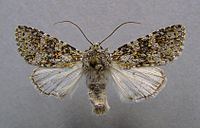Genus Polymixis Rank Species | ||
 | ||
Similar Polymixis, Polymixis flavicincta, Polymixis lichenea, Ammoconia caecimacula, Ammoconia senex | ||
Polymixis xanthomista, the black-banded polymixis, is a moth of the Noctuidae family. It is found in western Europe, southern Europe and east to Romania, Hungary and Slovenia and also in North Africa. In the Alps it can be found at up to 2000 metres above sea level.
Contents
Technical description and variation
Forewing greyish white, thickly dusted with blackish grey, the median area filled up with blackish; the edges of the lines and stigmata and the course of vein 1 picked out with yellow scales; the upper stigmata large and paler, the orbicular with a dark dot in middle; submarginal line preceded by wedgeshaped black marks; hindwing of male white, with the veins blackish and sometimes a slight grey submarginal band before the blackish marginal line; of female uniform dark grey; — nigrocincta Tr. , the more common form, is blacker, with the yellow scales more or less obsolete;- nivescens Stgr. from the chalk district of the Jura, Switzerland, has the ground colour of the basal and marginal areas much whiter; — statices Gregs. is a dark smaller race from the Isle of Man; its main difference is that the inner and outer lines edging the blackish median area are more distinctly and broadly white, especially below the middle; the amount of yellow scaling is variable.
Biology
Adults are on wing from the end of August to mid-October. Larva reddish-brown, thickly speckled with dark atoms, which form a dorsal and two broader subdorsal. The larvae feed on various plants, including Plantago, Taraxacum, Verbascum, Rumex, Lonicera and Prunus padus. Subspecies statices has been recorded on various low growing plants, including Armeria maritima and seems to prefer the flowers.
